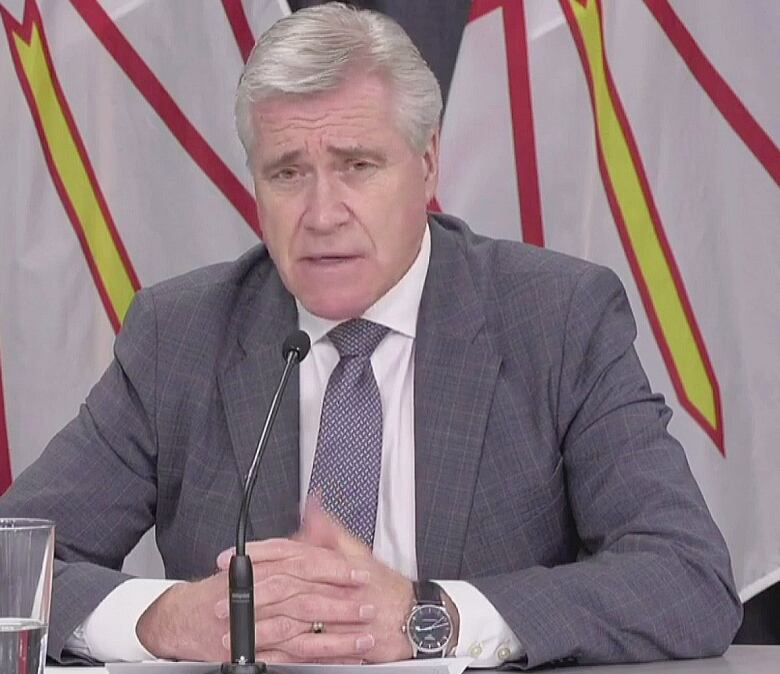N.L. may be planking the curve, but not the time to relax orders, premier says
2nd straight day of no new COVID-19 cases reported

No new cases of COVID-19 were reported in Newfoundland and Labrador on Monday, the second straight day in which which zero new cases were found.
The total caseload stands at 257.
While only one new casehas been reported in the last three days, Premier Dwight Ball said it's not time to ease up on public health restrictions.
"You just simply cannot start to relax your actions," he said."What we need is for everyone to continue to be responsible and be safe."
As of Monday191 people haverecovered from the virus, and 6,249 people have been tested.
Health Minister John Haggie said the province has been doing well in terms of staying put, referencing Google tracking data thatshoweda significant reduction in movement related to business and retail needs.
Haggie reiterated the importance of holding the line.
"It is too soon to say several days of low numbers means we have beaten it. We need to wait this out to find out how we then transition to what will quite frankly be a new abnormal rather than a return to the old normal," he said.
"With some more diligence and application I think we will be able toget through this in a way that brings us into a different normal."
Asked about what the benchmark will be for government to begin lifting restrictions, Dr. Janice Fitzgerald, the province's chief medical officer of health, said the trend in low to no new cases will have to exceed more than just two days. Fitzgerald said the provincial government is looking into what those indicators might be.
Haggie said some jurisdictions are using a benchmark of 14 days of slow growth, others are suggesting a rate at which a region's health-care infrastructure can manage new cases, andothers are suggesting a longer period of time than two weeks.
"It is a moving target," he said. "The challenges really are around what order one would consider reopening things."
However, there aren't any specific answers right now to any given scenario, Haggie said. Since the province lags behind mainland Canada by about two weeks, government is basing its moves onevidence andlessons learned in other jurisdictions, he added.
"I think the absence of answers forthe general public is not because of any desire not to tell anybody. It's simply the fact is that those questions are fundamentally not answerable in a detailed way at the moment," Haggie said.
And while some communities have seen very little impact as a result of the COVID-19 virus itself there are zero cases on the Bonavista Peninsula for example Ball said it's still not time to reopen the economy.
Once the province reaches a point where businesses can begin to reopen, said Ball, it will be done on a provincial level and not community by community, region by region. A mistake made in one area could expose the virus to a significant portion of the province, he said.
"Keep in mind it's a small population. People move back and forth," said Ball.
New models
Haggie said data collected over the last 10 days will be presented to Dr. Proton Rahmanand his team of analysts, who were responsible for the province's initial short-term COVID-19 projection model on April 8, to see what changes have occurred.

Haggie said he's confident the projection model will not be the same as it was then, given that the initial model included a large cluster in St. John's thatlikely skewed the data.
"We will get Dr.Rahman's team to look up those models again and we'll be in a position, hopefully in the next day or so, to see and advise people whether or not the model, that projection, has changed and if so in what way," he said.
"But exactly how that will change you're looking to a crystal ball and it's not very crystal clear, and it's really hard to use thesein any other way except for ageneral planning tool."
Fishery concerns
The week also begins with uncertainty swirling around the crab fishery. Over the weekend, the Fish, Food & Allied Workersunion called for the opening to be postponed until at least May 11, due to the COVID-19pandemic.
FFAWpresident Keith Sullivan said the recommendation will be sent to the Department of Fisheries and Oceans, which holds the authority to open or delay the fishery.
"We have to be able to ensure that we have a safe fishery for everyone involved," said Sullivan.
Meanwhile, the Fish Harvesting Safety Associationhas released 12 control measures to prevent the spread of COVID-19 on fishing vessels, if fisheries open later this spring.
TheCOVID-19 Safe Work Practicesinclude guidelines that recommend what vessel owner/operators should do ifa crew member gets sick while at sea.












_(720p).jpg)


 OFFICIAL HD MUSIC VIDEO.jpg)
.jpg)



























































































